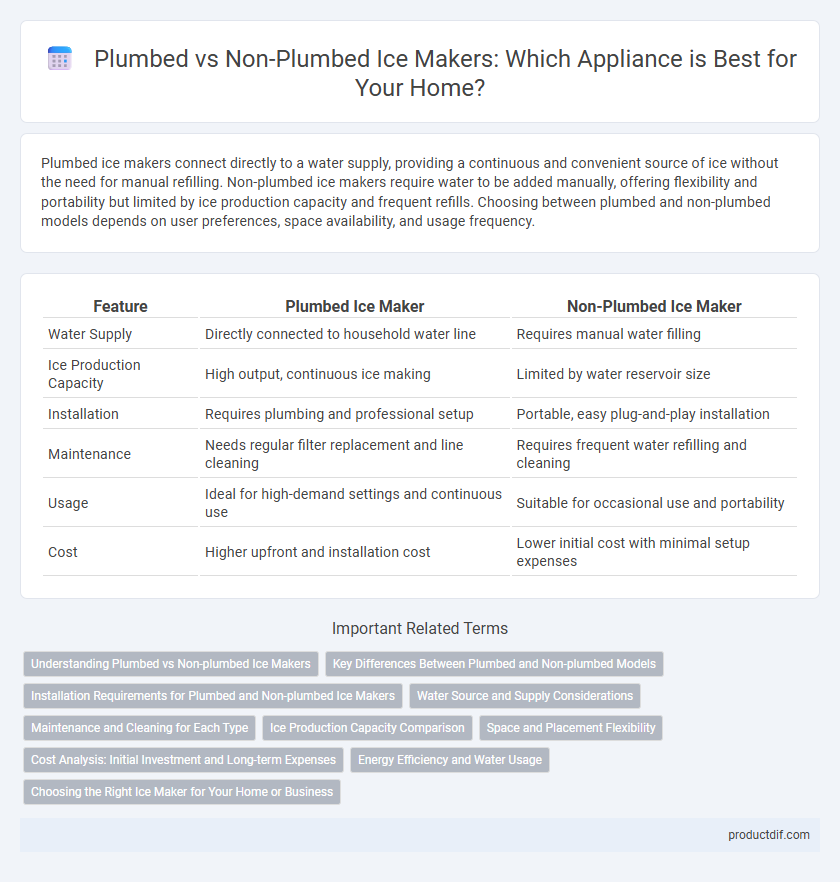Plumbed ice makers connect directly to a water supply, providing a continuous and convenient source of ice without the need for manual refilling. Non-plumbed ice makers require water to be added manually, offering flexibility and portability but limited by ice production capacity and frequent refills. Choosing between plumbed and non-plumbed models depends on user preferences, space availability, and usage frequency.
Table of Comparison
| Feature | Plumbed Ice Maker | Non-Plumbed Ice Maker |
|---|---|---|
| Water Supply | Directly connected to household water line | Requires manual water filling |
| Ice Production Capacity | High output, continuous ice making | Limited by water reservoir size |
| Installation | Requires plumbing and professional setup | Portable, easy plug-and-play installation |
| Maintenance | Needs regular filter replacement and line cleaning | Requires frequent water refilling and cleaning |
| Usage | Ideal for high-demand settings and continuous use | Suitable for occasional use and portability |
| Cost | Higher upfront and installation cost | Lower initial cost with minimal setup expenses |
Understanding Plumbed vs Non-plumbed Ice Makers
Plumbed ice makers connect directly to a water supply, providing a continuous flow of water for consistent ice production, ideal for high-demand environments. Non-plumbed ice makers require manual filling of an internal reservoir, offering portability and ease of installation without plumbing modifications. Choosing between plumbed and non-plumbed ice makers depends on usage needs, installation preferences, and available space.
Key Differences Between Plumbed and Non-plumbed Models
Plumbed ice makers connect directly to a water supply line, ensuring continuous ice production without manual refills, while non-plumbed models rely on a built-in reservoir that requires regular filling. Plumbed models typically offer higher ice output and are ideal for heavy use, whereas non-plumbed machines provide flexibility and portability for light to moderate ice demands. Maintenance differs as plumbed units require water line installation and potential leak checks, while non-plumbed units need frequent water replacement and reservoir cleaning.
Installation Requirements for Plumbed and Non-plumbed Ice Makers
Plumbed ice makers require a direct water line connection, professional installation, and access to a drainage system, ensuring continuous ice production without manual refilling. Non-plumbed ice makers operate with a built-in water reservoir, making installation simpler and more flexible, but they demand regular water refilling and ice removal. Selecting the appropriate model depends on available plumbing infrastructure, installation convenience, and long-term maintenance preferences.
Water Source and Supply Considerations
Plumbed ice makers connect directly to a water supply line, ensuring a continuous flow of water for consistent ice production without manual refilling. Non-plumbed ice makers rely on a built-in reservoir that requires manual filling and regular monitoring, making them ideal for locations without accessible water lines. Water source availability and supply convenience are crucial factors in selecting between plumbed and non-plumbed ice makers for efficient appliance operation.
Maintenance and Cleaning for Each Type
Plumbed ice makers require regular inspection of water lines and filters to prevent mineral buildup and ensure consistent ice quality, while non-plumbed models demand frequent manual refilling and cleaning to avoid mold and bacteria growth. Maintenance of plumbed units involves flushing the system and checking connections for leaks, whereas non-plumbed ice makers benefit from thorough wiping and sanitizing of the water reservoir after each use. Both types demand scheduled deep cleaning with approved ice machine cleaners to maintain hygiene and operational efficiency.
Ice Production Capacity Comparison
Plumbed ice makers typically produce between 50 to 500 pounds of ice per day due to their continuous water supply, making them ideal for high-demand settings. Non-plumbed ice makers generally have a lower capacity, averaging 20 to 100 pounds daily, as they rely on manually refilled water reservoirs. The choice between plumbed and non-plumbed models depends on required ice production capacity and installation flexibility.
Space and Placement Flexibility
Plumbed ice makers require a direct water connection, which limits placement options to areas near plumbing lines, often reducing flexibility in kitchen or bar design. Non-plumbed ice makers operate with internal reservoirs, allowing for greater mobility and installation in locations without access to water supply. This makes non-plumbed models ideal for small spaces or temporary setups where versatility in placement is essential.
Cost Analysis: Initial Investment and Long-term Expenses
Plumbed ice makers typically require a higher initial investment due to the cost of water line installation and professional setup, but they offer lower long-term expenses with continuous water supply and minimal manual refilling. Non-plumbed ice makers have a lower upfront cost and simple installation, yet their ongoing maintenance and frequent water refills can increase operational costs over time. Evaluating total cost of ownership involves balancing installation complexity against daily usage and maintenance efficiency.
Energy Efficiency and Water Usage
Plumbed ice makers connect directly to a water supply, offering continuous ice production with higher energy efficiency due to consistent water flow and automated operation. Non-plumbed ice makers rely on manual water filling, typically consuming more energy to maintain ice production cycles and potentially leading to higher water waste through inefficient refills. Choosing a plumbed model reduces water usage and energy consumption, making it a more sustainable option for frequent ice needs.
Choosing the Right Ice Maker for Your Home or Business
Plumbed ice makers connect directly to a water line, providing a continuous supply of ice ideal for high-demand environments such as restaurants or busy offices. Non-plumbed ice makers require manual water filling, offering greater portability and ease of installation, perfect for small households or occasional use in bars. Assess your daily ice consumption, installation feasibility, and space availability to select the most efficient and convenient ice maker for your home or business needs.
Plumbed vs Non-plumbed Ice Maker Infographic

 productdif.com
productdif.com